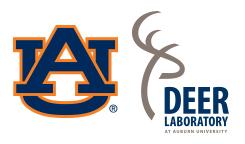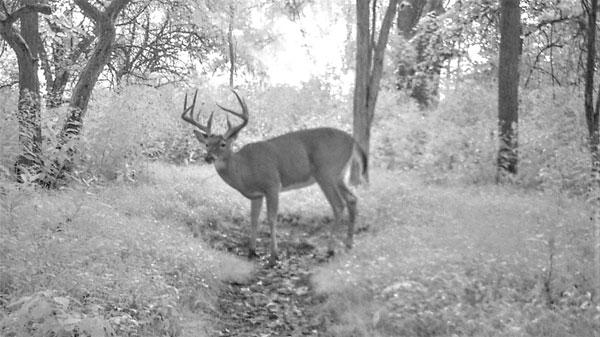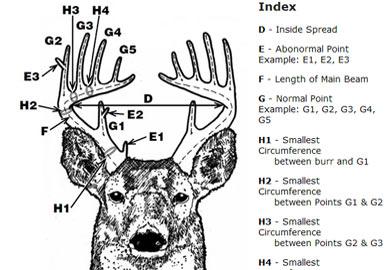White-tailed deer exhibit something scientists refer to as “sexual dimorphism.” This simply means the sexes differ in secondary as well as primary sexual characteristics. The fact that males grow antlers and females normally do not is one good example of a sex difference in whitetails.
The whitetail sexes also differ in many other aspects of their physiology and behavior. Males, for example, have higher nutritional requirements for growth, take longer to attain their maximum body size, and don’t normally live as long, as compared to females.
As with other ungulates (elk, moose, red deer, etc.), the adult whitetail sexes live separately except during the breeding season. This social and spacial separation is referred to as “sexual segregation” or “niche separation” of the sexes. As a result, adult male and female whitetails exhibit pronounced differences in their seasonal food and shelter requirements, as well as their social habits.
Healthy male whitetails also are considerably larger than females of the same age, a difference that widens with age.
Many studies have documented the effects of poor nutrition on whitetail body growth. Understandably, serious nutritional shortage results in smaller than normal deer. However, few researchers have specifically addressed the question of sex differences in body weight relative to diet changes or other factors.
Theoretically, as the male’s quality of life declines, sex differences in body weight should diminish, because males respond more sensitively in terms of retarded body growth. If so, then narrowing of sex differences in body weight, by age class, should signal the need to alter deer habitat and/or herd management strategies.
Resource Partitioning
While researching Lower Michigan’s enclosed George Reserve deer herd, Dale McCullough and his coworkers from the University of Michigan found that the whitetail sexes use space and habitat differently during the non-breeding season. Also, because of differences in diets and diet quality, they concluded that the sexes do not compete equally for the same resources — hence, exhibit resource partitioning.
Studies conducted by Floyd Weckerly and John Nelson in Tennessee, demonstrated diet differences between the whitetail sexes only in October. Therefore, they concluded resource partitioning might not be the same for Southern populations of white-tailed deer as for Northern populations.
In South Texas, John Kie and Terry Bowyer found that deer density was an important factor in determining how does and bucks utilized available habitat outside of the breeding season. When deer density increased, from around 100 deer to nearly 200 deer per square mile, in their study, sex segregation decreased for all seasons. They concluded that sex differences in diet are not the cause of sexual segregation, but are instead a consequence of spatial separation.
Most researchers agree that females select habitat that is best suited for rearing offspring. Normally, this means diversified food and cover arrangements and ample hiding cover for both mother and young as a predator defense during the critical stage of early fawn rearing.
On the other hand, males tend to select areas where nutrition is superb, which allows for maximal body growth necessary for the attainment of high dominance and improved breeding success. The importance of maximizing body condition for males apparently exceeds risk of predation.
McCullough warned that resource partitioning between the sexes in whitetails “adds a new dimension to the role of social behavior as it relates to deer management.” Likewise, Kie and Bowyer suggest “there is merit in considering males and females as separate species for the purpose of management.”
Indeed, if bucks differ from does in their use of space, food and cover resources on a seasonal basis, then deer herd and habitat management considerations take on an entirely new level of complexity — management practices that favor one sex might not necessarily benefit the other.
Growth Patterns
In order to grow properly, fawns require nourishing forage that has from 14% to 22% protein content, with males having higher requirements than females. By comparison, yearlings (1 1/2 years old), which are still growing, require 11% protein, whereas mature animals might require only from 6% to 10% protein in their diets for basic body maintenance.
In my studies, conducted with an enclosed population of supplementally fed deer in northern Michigan, females achieved about 88% of their adult skeletal size (as determined by hind-foot length) by 7 months of age, compared to 85% for males. At yearling age, females and males attained about 98% of their skeletal growth. All does and bucks achieved maximum hind-foot lengths by 2 1/2 years.
Seven-month-old doe fawns, yearlings and 2 1/2-year-olds reached about 52%, 83% and 94% of their mature body weights respectively, and maximum weights at 4 1/2 years. By comparison, buck fawns, yearlings and 2 1/2-year-olds reached about 43%, 69% and 81% of their mature weights respectively, but maximum weights not until 5 1/2 years.
Most other studies have shown similar growth patterns for whitetails, but there are exceptions. In Mississippi, body weights of males and females increased through 4 1/2 years on the more fertile soils, but only through 3 1/2 years on the less fertile lands. In north-central Minnesota, Todd Fuller and his coworkers found that bucks did not achieve 95% of their maximum dressed weight until 7 1/2 years of age.
It’s important to note that males accomplish most of their skeletal growth before they disperse from their natal range. This indicates that habitat preferred by matriarchal groups for fawn-rearing might ultimately determine buck physical size.
As Newborns
Fawn birth weights — and survival prospects — hinge heavily upon their mother’s nutrition during the final one-third of pregnancy. Stunted individuals born to malnourished mothers might weigh only about 2 pounds, whereas healthy ones could weigh 10 pounds or more. Typically, single fawns weigh more than those from twin or triplet litters.
Even at birth, male fawns tend to be about one-half pound heavier than females among mixed sex litters. Since this weight differential increases slightly as the mother’s nutritional plane declines, Michigan researcher Lou Verme suggests that males show “innately better resistance to prenatal hardship.”
The mother’s milk yield might decline if she is under-nourished, but its quality doesn’t change. According to Verme, if the doe gets sufficient food to support favorable lactation, her milk will be of excellent quality. As a result, her fawns will gain nearly one-half pound per day during the first month.
The Growing Fawn
On Northern range, autumn harvested male fawns are normally 5% to 10% heavier than female fawns, but the sex difference seems to be less pronounced on Southern range.
When poorly nourished, this weight differential may be reduced. For example, deer herd condition was extremely poor on North Manitou Island, located in Lake Michigan, when David Case and McCullough studied it in 1980. Male and female fawns they handled had identical average dressed weights of only 42 pounds.
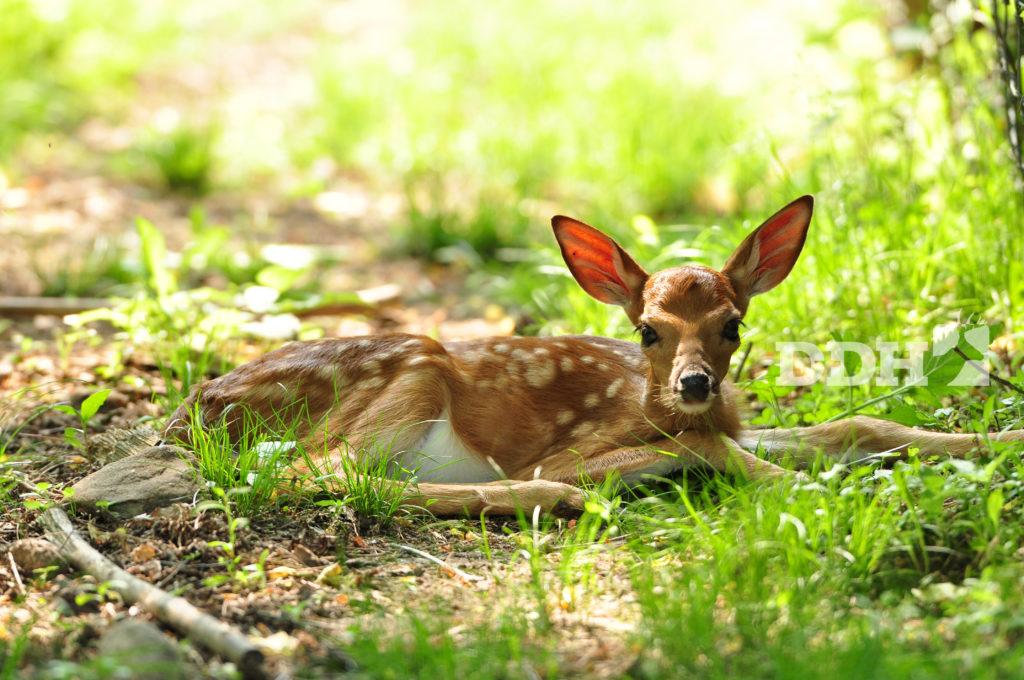
Bronson Strickland and Stephen Demarais demonstrated that the growth rate of deer also can vary according to soil fertility. In Mississippi, deer with the largest dressed weights were taken from the fertile soils of the Delta region, whereas the smallest-bodied deer came from the poorest soils of Coastal Flatlands.
Although male fawns from the fertile soil region outweighed female fawns by about 4% (54 pounds vs. 52 pounds, respectively), female fawns were actually 7% heavier than male fawns from the poor soil region (41 pounds vs. 38 pounds, respectively). These data not only demonstrate that regional differences in soil fertility impact deer body size, they show that young males respond more sensitively to nutritional shortages than females do.
Although John Gill couldn’t explain his findings, he also reported differences in dressed weights of deer from four regions in West Virginia. Male and female fawns taken from the West Region were the largest (66 pounds and 61 pounds, respectively), an 8% difference in favor of males; the smallest came from the East Region (44 pounds and 43 pounds, respectively), a 2% difference. Skeletal measurements followed the same trend, with West Region female fawns having longer hind feet than East Region male fawns.
In our studies at Cusino, we found that 10 weeks of an inadequate autumn diet (October throughout mid-December) stunted fawn growth, but the sexes seemed to suffer equally. That is, compared to those on unlimited feed, dressed weights of underfed male fawns were 20 pounds lighter (71 pounds vs. 51 pounds, respectively). Nearly the same difference was noted for females (65 pounds vs. 46 pounds, respectively). So we did not find a narrowing of sex differences in body weight as the quality of the autumn diet declined; even poorly nourished male fawns were 8% to 10% heavier than underfed females.
It’s important to recognize that fawns start supplementing their milk diet with succulent herbaceous forage when only a few weeks old. Therefore, forage deficiency during summer can have double barreled negative effects on the growth of fawns: (1) under-nourished mothers produce less milk for her fawns, and (2) young fawns find less nutritious forage to supplement a decreased milk supply.
Clearly, poor nutrition during the fawn’s first seven months stunts their growth. However, compared to females, male fawns appear to be especially sensitive to nutritional shortage during the first four months (i.e., summer). In contrast, poor nutrition during autumn seems to adversely impact young males and females about equally.
Yearlings Are Sensitive, Too
Well-nourished yearling bucks usually average 10% to 20% heavier than female yearlings. As in the case of fawns, this sex difference tends to narrow with poor nutrition for deer on Northern range. However, based on data collected by Strickland and Demarias in Mississippi, this might not be true for Southern deer.
Especially small yearling bucks have been reported from some islands in the Upper Great Lakes. For example, herd condition is poor on Bois Blanc Island located in northern Lake Huron, where field-dressed yearling bucks had an average weight of 83 pounds, compared to 81 pounds for female yearlings — a mere 2% sex difference.
Similar dressed-weight relationships were noted for yearlings harvested on some Lake Michigan islands. On Beaver Island, hunter-harvested yearling bucks averaged 86 pounds compared to 84 pounds for female yearlings. Yearling males and females taken from North Manitou had identical average dressed weights of 88 pounds.
Meanwhile, yearling deer taken on South Fox Island, in Lake Michigan, were in excellent condition. Males had an average dressed weight of 115 pounds compared to 97 pounds for females — a 16% sex difference.
Although yearling deer harvested on infertile soils in Mississippi were grossly under weight (males 77 pounds, females 63 pounds), the sex difference in average dressed weights amounted to 18%. Those yearlings harvested from the East Region of West Virginia were also small (males 79 pounds, females 72 pounds), but males there outweighed females by only 9%.
Whatever the cause, small fawns generally grow to be small yearlings. As a result, a large proportion of under-sized yearling does might fail to breed, whereas small yearling bucks normally grow small antlers.
Density Stress Effects
Even on reasonably fertile range, crowding at high deer density can negatively impact physical development of young whitetails. In the 1980s, we found average dressed weights for fawns and yearlings respectable, but highly variable, from Upper Michigan’s Menominee County, where density exceeded 100 deer per square mile.
For example, the largest buck fawns had heavier dressed weights than the smallest yearling bucks (95 pounds vs. 73 pounds, respectively). The same was true for young females. In fact, some doe fawns were heavier than some yearling bucks (85 pounds vs. 73 pounds, respectively). Some small male fawns didn’t even grow antler pedicles, whereas a relatively high proportion of the yearling bucks carried short spike antlers less than 3 inches long.
Normally, you would expect to find such body weight relationships in areas where the breeding season is prolonged. That is, given good nutrition, you would expect early born male fawns to grow to large size at yearling age, and carry respectable antlers. In contrast, late-born individuals more likely develop into inferior yearlings — as is often the case in the South.
However, in northern Michigan, the rut is generally brief, due to the onset of harsh winter weather. In addition, few normally late-breeding doe fawns breed in this environment. As a result, because fawn-rearing does are territorial, we believe that young subordinate does were relegated the poorest habitat due to crowding and raised the smallest fawns because of nutritional shortage.
Other Factors Impact Adults
In most areas, autumn harvested 2 1/2-year-old bucks are 20 to 30% heavier than females of the same age; bucks 3 1/2 years of age and older are typically 30% to 40% heavier than females of the same age. These sex differences in body weight seem to prevail from North to South regardless of nutritional status. But, again, there are exceptions, and sometimes factors other than nutrition come into play.
Timing of the buck harvest and autumn nutrition also can be important factors affecting recorded sex differences in whitetail body weights. Given excellent nutrition, mature bucks might average as much as 50% heavier than same age females at the start of the breeding season. However, poor summer/autumn nutrition due to drought, early snow cover, mast crop failure, or other factors might impact males more so than females and lower this sex weight differential.
Since most bucks are harvested during the rut, they seldom are taken at peak body weight. Post-rut, the sex weight differential might be less than 20% for 2 1/2-year-olds, and less than 30% for older deer, due to rut-related fat depletion.
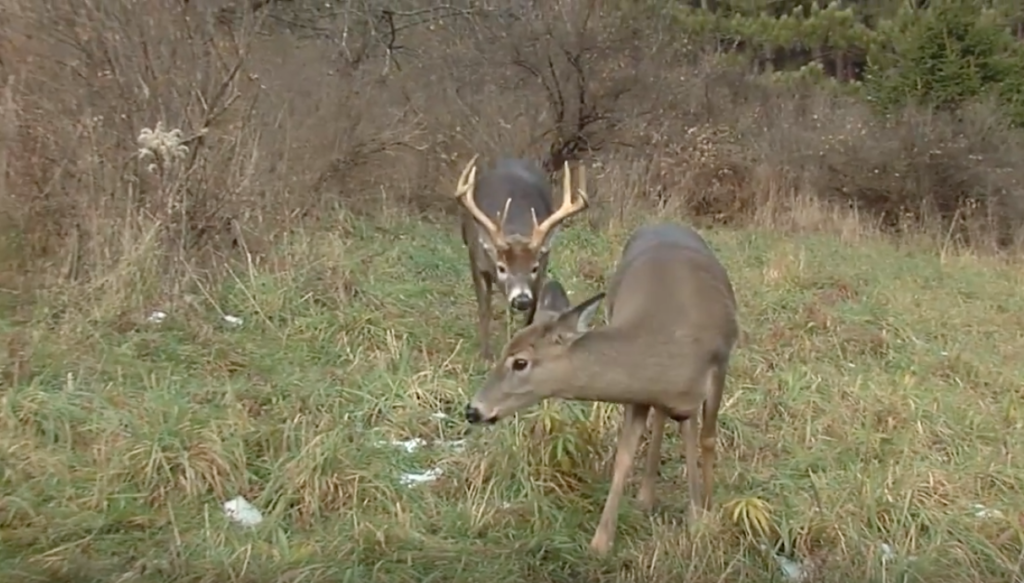
Presumably, productivity of young does can also affect sex differences in body size. Given the immense energy drain associated with raising fawns, successful young does might sacrifice body growth, and never reach their potential maximum body size. If so, this could widen the sex body weight difference. In contrast, not raising fawns until later in life might permit females to achieve larger size when mature, thereby narrowing the sex body weight difference. While this seems to be the case on Northern range, I know of no published data to prove the point.
Harvest Strategy Effects
Harvest strategies can also influence herd sex-age composition and sex body weight differences. For example, where 70% or more of the bucks are harvested annually, buck age structures tend to be very young. This means 1 1/2- and 2 1/2-year-old bucks must prematurely become herd sires and expend an unusual amount of energy during the rut.
Unusually high energy expenditure among immature bucks can retard their growth rates and prevent them from achieving their maximum physical size at maturity — narrowing the male-female body weight differential — and even increasing buck mortality from natural causes.
According to Strickland and Demarais, excessive buck harvesting, coupled with selective harvest strategies (i.e., antler restrictions) designed to protect small-antlered bucks and allow harvest of large-antlered young bucks, can ultimately degrade average antler size — as well as buck body size, since the two generally go together.
I’ve seen this happen on some hunt clubs in Lower Michigan, where harvested yearling bucks were about 15% heavier than yearling females, indicating favorable growth. However, 2 1/2-year-old bucks had average dressed-weights of about 130 pounds, compared to 104 pounds for same age does — a 19% difference. At the same time, 3 1/2-year-old bucks dressed-out at 141 pounds, compared to 107 pounds for same age females — a 24% difference. In each case, the sex difference should have been 10 to 15% higher, suggesting that the largest-bodied yearling bucks were being removed, leaving smaller-bodied individuals to populate older age classes.
Conclusions
Well-nourished male whitetails are inherently larger than females from birth to maturity. While this sex difference might be most pronounced in the North — where large body size enhances the prospects for winter survival — deer in the South demonstrate the same phenomenon. Small-bodied deer, and narrow sex differences in body size within an age class, signal the need to alter existing management practices.
Poor nutrition during the first four months tends to narrow the sex differences in body weight among fawns and yearlings, and contributes to under-sized mature deer. However, despite the male’s higher nutritional requirements for growth, sex differences in body size widen with a deer’s age.
Apparently, nutritionally stressed male fawns exhibit greater compensatory growth later in life than do females. However, excessive buck harvesting coupled with selective removal of the best young bucks (i.e., high-grading) can depress body size of older bucks, thereby narrowing sex size differences.
From a management perspective, the best advice is to maintain diversified habitat that satisfies the contrasting seasonal food and cover requirements of the sexes. This also means controlling the number of antlerless deer to prevent crowding on preferred fawn-rearing range, to assure that young deer are adequately nourished.
In addition, strive to maintain populations with more natural (i.e., balanced) sex-age structures, but avoid high-grading. This will tend to widen sex differences in body size and produce larger bucks better able to cope with natural mortality factors.
— John J. Ozoga is one of North America’s most respected deer research biologists. He holds bachelor and master of science degrees in wildlife management from Michigan State University. He worked at the Cusino Wildlife Research Station for more than 33 years, where he wrote or co-wrote more than 80 technical papers, including some of the most comprehensive scientific studies on white-tailed deer ecology, physiology, reproduction, nutrition, behavior and population dynamics. Ozoga retired and became Deer & Deer Hunting’s freelance research editor in 1994.
D+DH In-Depth is our premium, comprehensive corner on America’s No. 1 game animal. In this graduate-level course, we’ll teach you about deer biology, behavior, and ultimately, how to become a better hunter. Want to be the first to get our premium content? Become a D+DH Insider for FREE!

LITERATURE CITED
Banasiak, C.F. 1961. “Deer in Maine.” Game Division Bulletin No. 6, Department of Inland Fisheries and Game, Agusta, Maine.
Beier, P. 1987. “Sex Differences in Quality of White-tailed Deer Diets.” Journal of Mammalogy 68:323-329.
Case, D.J. and D.R. McCullough. 1987. “The White-tailed Deer of North Manitou Island.” Hilgardia 55 (9):1-56.
Gill, J. 1956. “Regional Differences in Size and Productivity of Deer in West Virginia. Journal of Wildlife Management 20:286-292.
Kie, J.G. and R.T. Bowyer. 1999. “Sexual Segregation in White-tailed Deer: Density-dependent Changes in Use of Space, Habitat Selection and Dietary Niche.” Journal of Mammalogy 80:1004-1020.
McCullough, D.R., D.H. Hirth and S.J. Newhouse. 1989. “Resource Partitioning Between the Sexes in White-tailed Deer.” Journal of Wildife Management 53:277-283.
Rosebery, J.L. and W.D. Klimstra. 1975. “Some Morpholgoical Characteristics of the Crab Orchard Deer Herd.” Journal of Wildlife Management 39:48-58.
Strickland, B.K. and S. Demarais. 2000. “Age and Regional Differences in Antlers and Mass of White-tailed Deer.” Journal of Wildlife Management 64:903-911.
Strickland, B.K. and S. Demarais. No Date. “Using Antler Restrictions to Manage for Older-aged Bucks.” Publication 2427, Extension Service Mississippi State University.
Weckerly, F.W. and J.P. Nelson Jr. 1990. “Age and Sex Differences in White-tailed Deer Diet Composition, Quality and Calcium.” Journal of Wildlife Management 54:532-538.
Verme, L.J. 1962. “Mortality of White-tailed Deer Fawns in Relation to Nutrition.” National Deer Disease Symposium Proceedings 1:15-38.
